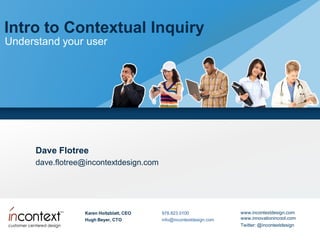
Intro to Contextual Inquiry: Understand Your User
- 1. Intro to Contextual Inquiry Understand your user Dave Flotree dave.flotree@incontextdesign.com Karen Holtzblatt, CEO 978.823.0100 www.incontextdesign.com Hugh Beyer, CTO info@incontextdesign.com www.innovationincool.com Twitter: @incontextdesign
- 2. Contextual Inquiry Provides reliable, detailed knowledge of what people actually do and what they really care about
- 3. Contextual Inquiry A set of principles, not steps Context Partnership Interpretation Focus
- 4. The principle of Context What people say they do And what they actually do Are different
- 5. What is Context? Get as close to the work as possible Go to the customer Interview while they are working Be grounded in real objects and events Pay attention to non-verbal communication Ongoing work versus summary experience People tend to give summaries Ongoing work is never summarized Stay concrete, don’t abstract Ongoing work. “Show me…” Recent retrospective account . “When was the last time you…” Look at artifacts
- 6. Don’t summarize, don’t abstract What do you do when you go grocery shopping?
- 7. The principle of Partnership People know everything about what they do… They just can’t tell you
- 8. What is Partnership? Partnership as relationship The user is the expert So follow their lead Withdrawal Help the users articulate and see their work practice Avoid ineffective interview styles The Traditional Interviewer The Expert/Novice Return The Guest/Host Apprenticeship is the preferred model Listen, learn, be humble, don’t judge And assume that people do things for a reason Return to the ongoing work • It always keeps you in the apprenticeship model
- 9. The principle of Interpretation It’s not the facts that matter… It’s the interpretation of the facts
- 10. What is Interpretation? Interpretation is the data A shared understanding of what is going on Customer Offer interpretations • Don’t ask open-ended questions Fact Listen for the “No” tune the interpretation Huh? Umm... could be Hypothesis “They” would like it “Yes” comes with elaboration Implication Watch for non-verbal clues Check your design ideas as they occur Design Idea
- 11. The principle of Focus “What you know, you know, what you don't know, you don't know. This is true wisdom.” - Confucius
- 12. What is Focus? Know your purpose entering focus We all have an entering focus what • A set of preconceived assumptions and beliefs we make Drive interviews with your project focus up what we assume • Clear idea of what work you are trying to understand about the user’s Expand your focus world what we see • Challenge your assumptions, probe the unexpected Probe to expand focus Surprises and contradictions “Nods” — What you assume is true What you do not know The problem behind solutions what we miss user’s world
- 13. Contextual Inquiry Context Partnership Interpretation Focus
- 14. How to get started It doesn’t take many interviews 3-5 people who do the same activity can characterize markets of millions Rule of thumb for numbers of interviewees • 4 for each work role; 3 in each significant context (e.g., skill level, tech savvy) • 3 organizations of each significant type (e.g., size, geography) Make the data you bring back actionable Use a process like an interpretation session with other people Create session notes (virtual Post-Its) and diagrams you can use to… Build an affinity diagram and other work models as appropriate Reveals underlying pattern: intent, strategy, structure, and scope Shows what matters to the entire population, keeping variations that matter Eliminates focusing on individual users Provides real data for design thinking, personas, scenarios, user stories
- 15. Sign up for the webinar: Adopting Agile: Successful UX in an Agile World November 27th www.incontextdesign.com Thanks! Dave Flotree dave.flotree@incontextdesign.com
